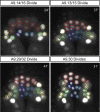Nodal and FGF coordinate ascidian neural tube morphogenesis
- PMID: 27827820
- PMCID: PMC5201037
- DOI: 10.1242/dev.144733
Nodal and FGF coordinate ascidian neural tube morphogenesis
Abstract
Formation of the vertebrate neural tube represents one of the premier examples of morphogenesis in animal development. Here, we investigate this process in the simple chordate Ciona intestinalis Previous studies have implicated Nodal and FGF signals in the specification of lateral and ventral neural progenitors. We show that these signals also control the detailed cellular behaviors underlying morphogenesis of the neural tube. Live-imaging experiments show that FGF controls the intercalary movements of ventral neural progenitors, whereas Nodal is essential for the characteristic stacking behavior of lateral cells. Ectopic activation of FGF signaling is sufficient to induce intercalary behaviors in cells that have not received Nodal. In the absence of FGF and Nodal, neural progenitors exhibit a default behavior of sequential cell divisions, and fail to undergo the intercalary and stacking behaviors essential for normal morphogenesis. Thus, cell specification events occurring prior to completion of gastrulation coordinate the morphogenetic movements underlying the organization of the neural tube.
Keywords: Ascidian; FGF; Intercalation; Morphogenesis; Neurulation; Nodal.
© 2016. Published by The Company of Biologists Ltd.
Conflict of interest statement
The authors declare no competing or financial interests.
Figures










References
-
- Christiaen L., Wagner E., Shi W. and Levine M. (2009a). Isolation of sea squirt (Ciona) gametes, fertilization, dechorionation, and development. Cold Spring Harb. Protoc. 2009, pdb.prot5344. - PubMed
-
- Christiaen L., Wagner E., Shi W. and Levine M. (2009b). Electroporation of transgenic DNAs in the Sea Squirt Ciona. Cold Spring Harb. Protoc. 2009, pdb.prot5345. - PubMed
Publication types
MeSH terms
Substances
Grants and funding
LinkOut - more resources
Full Text Sources
Other Literature Sources

